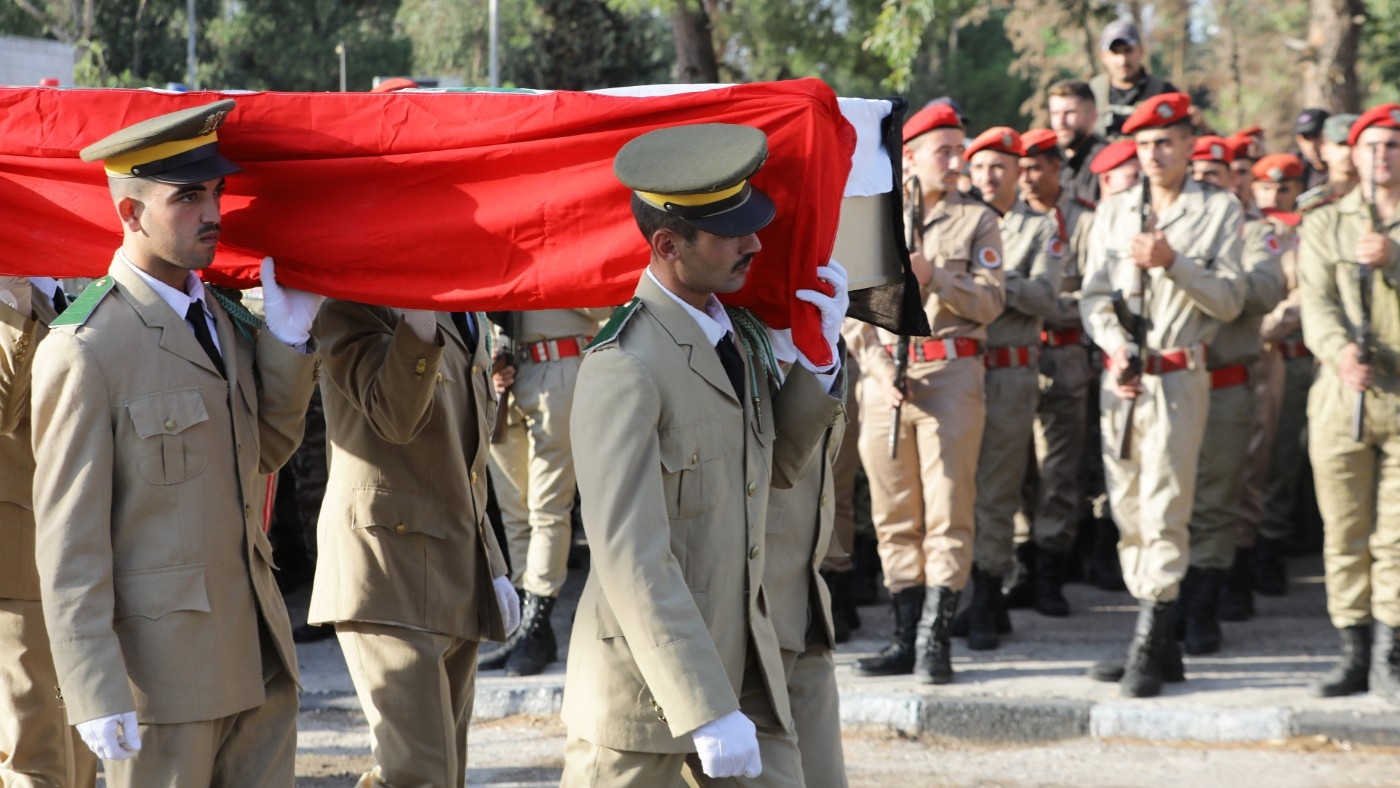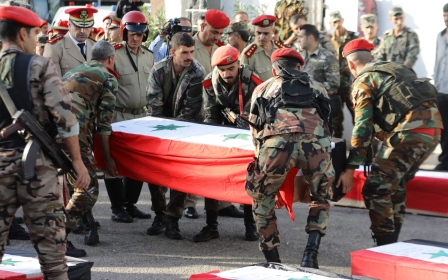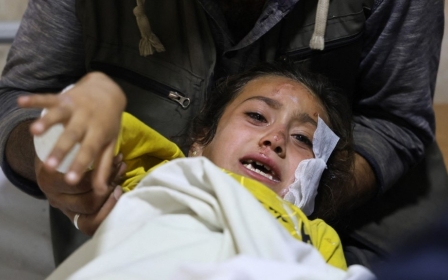Syria: Who is responsible for the Homs military academy attack?

Last Wednesday’s bloody attack on a Syrian government military college in Homs remains a mystery, with questions still swirling about the identity of the attackers, their goals and the weapons they used.
Some 100 people were killed in the attack in central Syria, with most of the victims set to graduate from the college as lieutenants after four years of tough military training.
Founded by the French in 1933, the Homs Military Academy has been accused of favouring applicants from the Syrian coast, the stronghold of President Bashar al-Assad's Alawite sect.
The annual graduation ceremony includes a large military parade and is attended by elite army, security and intelligence officers. But no high-level casualties have been reported in the attack, with the Syrian defence minister leaving before it took place, according to Russian media.
In a statement, Syria’s defence ministry said that “armed terrorist organisations” that receive international support had carried out the attack using drones. Government forces have responded by hitting the last rebel stronghold in the north of the country, killing at least 14 people, including four children.
New MEE newsletter: Jerusalem Dispatch
Sign up to get the latest insights and analysis on Israel-Palestine, alongside Turkey Unpacked and other MEE newsletters
In turn, rebel forces launched rocket attacks on pro-government areas in Aleppo, Hama and Latakia provinces, injuring more than 20 civilians and killing two, according to pro-government media.
The UN, UK and Swedish envoys to Syria have expressed their concern over the escalation, while France has called on all parties to exercise restraint and protect civilian populations.
There are 830 foreign military bases in Syria, with Russia, Iran, Turkey and US-led coalitions all having a military presence in the country. Iranian, Lebanese, Iraqi and Afghan militias loyal to the government are also deployed, and the country is under large-scale Israeli attacks.
Twelve years of conflict in Syria have created an environment in which attacks like the one on the Homs academy are hard to get to the bottom of. No-one has claimed responsibility yet, but there are three main suspects.
The rebels
In addition to dozens of Islamic factions, there are hundreds of other groups that have lost the support of the US-led international coalition and enjoy Turkish support. These factions are not united and are beset by internal conflict.
Since the beginning of the Syrian war, rebels have developed many indigenous weapons, but the results have been limited and often expensive.
'It is 80km away from us, our attack drones have a maximum range of 40km'
- Syrian rebel leader
“All rebel forces do not have the strength to launch a similar attack in Homs,” a rebel leader told local media.
“It is 80km away from us, our attack drones have a maximum range of 40km,” a high-ranking rebel leader working on developing drones in northern Syria told Middle East Eye.
“Moreover, our drones cannot carry explosives capable of causing similar losses, our capacity is less than 15 kg,” he said.
“We are talking about 100 dead and twice as many wounded, and this is an expensive operation. For us, we will hit the officers if we reach the scene of the attack, not the trainees,” the source said.
“The drone shown by pro-regime [government] media is illogical. If that drone was responsible for the attack, it would break up into smaller pieces.”
In recent years, the hardline group Tahrir al-Sham (HTS), which controls Idlib in northwestern Syria, was responsible for several drone attacks that struck Hmeimim, the largest Russian military base in the Mediterranean.
But a rebel military source told MEE that HTS’s manufacturing warehouse was targeted by Russian attacks last month in response to the militant group’s arrest of a local informant network operating for the Russian military.
The US and its allies
Despite the failure of Turkish efforts to reconcile with the Syrian government - and the fact that Turkish bases in Syria are under constant Syrian attacks - military experts believe that Turkey, which has a thriving drone industry, does not have the intelligence capabilities inside Syria to launch an attack like the one on the military academy.
Last Wednesday, US forces also shot down a Turkish drone in Syria, a development that reflects the changing behaviour of US forces in Syria, which are under military pressure from Turkey as well as Syrian government forces and their allies Russia and Iran.
The Assad government has pledged to expel US forces, and tensions are rising between the two sides as Syria indirectly supported local forces waging a rebellion against the US-backed Syrian Democratic Forces in recent months.
'There has not been any similar Israeli or US attack throughout the 12 years of the Syrian war, targeting civilians on this scale'
- Waiel Olwan, researcher
Most of the pro-Assad Syrian public support the idea that external forces like Israel or the US were behind the Homs attack – and all other crises afflicting their country.
So far, however, Syrian authorities have provided no evidence proving the involvement of foreign forces or foreign-backed Syrian forces in the attack.
“I don't believe in conspiracy theories. I think there should be an international investigation,” Bassam Barabandi, a former Syrian diplomat and researcher stationed in the US, told MEE.
“If Israel had been involved, we would have seen a huge reaction from Iran,” he said.
“There were civilians, the families of the graduates, among the victims. There has not been any similar Israeli or US attack throughout the 12 years of the Syrian war, targeting civilians on this scale,” Waiel Olwan, a researcher at the Jusoor for Studies centre based in Turkey, told MEE.
“Israel’s strategy is to strike military facilities that pose a threat to Israeli national security, linked to military industrial development facilities belonging to the Iranian Revolutionary Guard Corps (IRGC) and Hezbollah in Syria.
Syrian forces and their allies
“All the facts indicate that Iran and Syria are responsible for and behind this attack,” Mustafa al-Bakour, a former Syrian colonel who defected and is now an opposition leader, told MEE.
“Iranian and Syrian authorities are the biggest beneficiaries of what happened and is happening now,” he said, referring to the attacks on Idlib.
Al-Bakour and Olwan see the attack as a pretext to strike opposition areas.
“Iran is trying to shuffle the cards and increase tension in the region, after the international coalition moved to close the Syrian Iraqi borders,” he said
The US recently supported operations to secure the closure of the Syrian border, especially the area of Al-Bukamal, which had been subjected to many Israeli attacks and is considered the main point of entry for Iranian forces and allied militias into Syria.
In messages to Syria's defence minister and to the Syrian armed forces, IRGC commander Hossein Salami strongly condemned the attack on the military academy at Homs, saying that those involved would pay a heavy price.
“Iran is now trying to increase tension and pressure on the Alawite sect [to which al-Assad belongs] to silence the opposition voices that have recently called for Assad to step down from power and hold him responsible for the deteriorating situation in the country,” al-Bakour said.
“It also aims to obscure the [anti-Assad] protests in Suwayda and influence the local population and make them preoccupied with feeling tension and fear instead of thinking about rebellion due to the poor living conditions,” he added.
Dozens of unknown explosions have occurred in government-controlled areas over the years without any party claiming responsibility for them.
There was no reaction from Syrian and Russian air defence systems to the military academy attack, and pro-government media did not publish any clear footage from the site.
Middle East Eye delivers independent and unrivalled coverage and analysis of the Middle East, North Africa and beyond. To learn more about republishing this content and the associated fees, please fill out this form. More about MEE can be found here.





